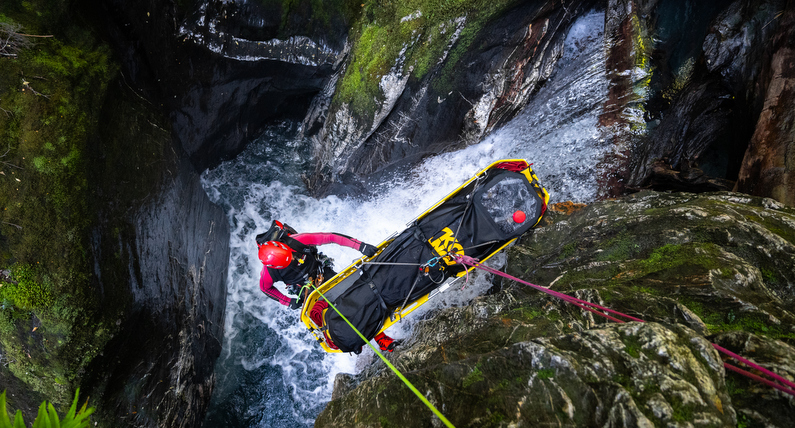
Clearing the canyons
More than 50 people from a range of organisations and agencies participated in the bi-annual National Canyon Search and Rescue Exercise (SAREX) held in the Queenstown Lakes District on 1 March 2024.
At the Makarora Fire Station, the Incident Controller explained the scenario. A pair of hitch-hiking social media influencers had told friends they intended to photograph some famous gorges near Haast Pass. The pair failed to turn up to a social gathering, sparking a comprehensive search by air and ground involving field teams and canyon teams from Land Search and Rescue.
“It's a complicated environment to operate in,” says Dan Clearwater, SAREX organiser and Wānaka Canyon team coordinator. “We are managing exposure to heights, swiftwater hazards and cold temperatures, whilst needing to effectively search areas such as log jams, rock sieves and undercuts where a person could become entrapped.”
There are about 100 trained Canyon SAR volunteers, who are part of teams based in the greater Auckland area, Central Plateau, Wellington, Motueka, Hokitika, Christchurch and Wānaka. “This SAREX gave us the chance to share knowledge and promote national consistency in our techniques,” says Dan.
Canyon SAR volunteers use wetsuits for protection against lengthy exposure to swift, cold water. Harnesses, ropes and technical gear allow them to abseil down waterfalls and progress through the canyons. They use diving masks and snorkels to search pools, and in highly turbulent water, use avalanche probes or GoPro cameras on a selfie stick.
This year the SAREX had observers from Australian and Taiwanese Canyon SAR teams, plus Police SAR coordinators and staff from the Rescue Coordination Centre New Zealand. Relationship building was a key aim of the SAREX.
“We are trying to help the coordinating authorities understand what we can do: safely and effectively search in and around gorges, canyons and waterfalls. Then we can rescue or recover people from those environments.”
After a morning of searching, mannequins simulating the two deceased influencers were found in Robinson Creek canyon. A radio repeater had been installed with the help of Wānaka Search and Rescue chairperson Bill Day and his helicopter. This repeater enabled the Wānaka-led incident management team to re-task the canyoners to the recovery operation. At the staging area, the Makarora Volunteer Fire Brigade provided a freshwater biosecurity wash.
Two police officers donned canyoning gear, and were guided to the scene to conduct an examination. Then, after a karakia was said, the mannequins were loaded into floating canyon rescue stretchers. Rope systems were rigged to lower each stretcher down four more waterfalls within the gorge, the largest being 25-metres high.
Wānaka Police SAR coordinator Alan Lee was impressed. “Those canyons are intimidating, cold, and high-risk environments, but the team were obviously in their element. They did a fantastic job of finding and recovering the mannequins.”
Coordinating authorities can reach the Canyon teams using the NZSAR Resources database: nzsar-resources.org.nz
Local team contacts are also available at: nzcanyoningassociation.org/rescue
Feature image: Canyon teams are trained in vertical rescue, using techniques that also manage swiftwater hazards. Courtesy Eugene Yeo.
This story was originally published in the June 2024 issue of Link magazine.
